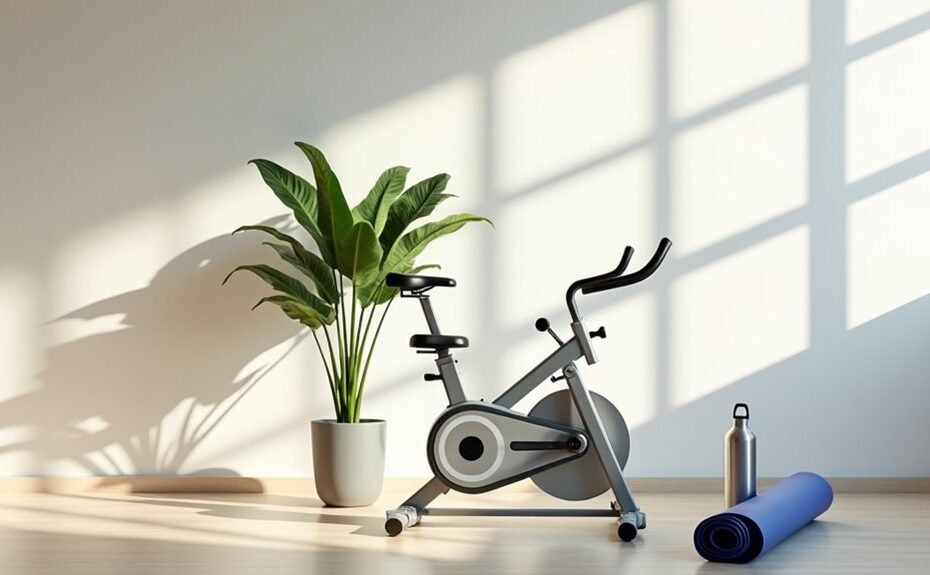I've spent years helping cyclists maximize their performance on static bikes, and I'll tell you this: proper breathing technique is the game-changer most riders overlook. While you might think pedaling harder is the key to better results, it's actually your breathing pattern that can make or break your workout efficiency. As a cycling coach, I've seen how mastering breath control can transform an average session into a powerful training experience. There's more to breathing than just inhaling and exhaling, and what I'm about to share will revolutionize your approach to indoor cycling.
Some of the links in this article may be affiliate links. If you make a purchase through these links, we may earn a small commission at no extra cost to you. Thank you.
Key Takeaways
- Practice diaphragmatic breathing by engaging your belly rather than chest muscles during rides to strengthen respiratory capacity.
- Synchronize your breathing rhythm with pedal strokes, typically exhaling during power phases for improved efficiency.
- Alternate between high-intensity intervals and recovery periods to challenge and adapt your respiratory system.
- Maintain proper posture on the bike to allow optimal diaphragm function and maximize oxygen intake.
- Implement progressive overload by gradually increasing workout intensity while focusing on controlled breathing techniques.
The Science Behind Breathing
Breathing is far more complex than just inhaling and exhaling. When I train cyclists, I explain how your diaphragm and intercostal muscles work together like a sophisticated pump. They contract during inspiration, expanding your thoracic cavity and creating negative pressure that pulls air into your lungs. It's pure physics – air flows from high to low pressure areas, just like drafting behind another rider. Indoor cycling benefits can significantly improve respiratory efficiency and lung capacity.
Let's get technical for a moment. Your respiratory center's playing chess while you're spinning those pedals. It's monitoring CO2, O2, and acid levels in your blood through specialized chemoreceptors. When you're hammering up a hill and CO2 spikes, these receptors scream "breathe faster!" to your brain. Slow yogic breathing can effectively stabilize these variables during intense exercise. When stress hits during a tough ride, many cyclists default to shallow chest breathing, which can worsen performance.
But here's the kicker – you can actually control this system. Unlike your heartbeat or digestion, breathing is the only autonomic function you can consciously manipulate. That's your secret weapon on the bike. By mastering your breath, you're not just moving air – you're controlling your nervous system, managing stress, and optimizing oxygen delivery to those hungry muscles. Trust me, this isn't just biology class; it's your ticket to better performance.
Mastering Your Breathing Technique
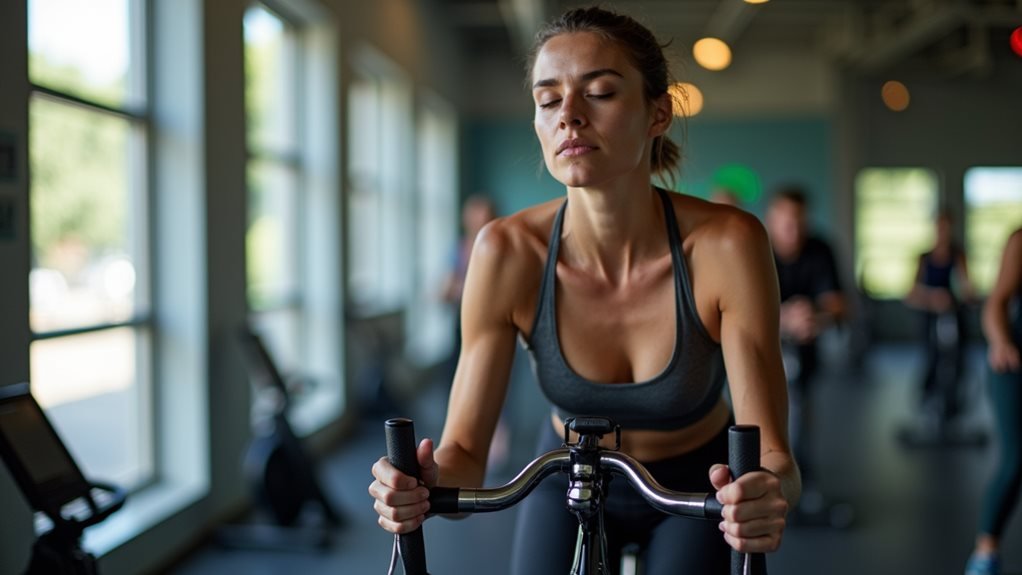
Now that you grasp the science, I'll show you how to put this knowledge into action. Let's start with the foundation: diaphragmatic breathing. Picture your belly as a balloon – when you inhale, it should expand outward. If your shoulders rise instead, you're doing it wrong. Maintaining upright posture during your rides ensures optimal breathing mechanics. Cycling HIIT can dramatically improve lung capacity by challenging your cardiovascular system.
First, sit upright on your bike and breathe through your nose. Count "in-two, hold-two, out-four." That's your baseline rhythm. Once you've got that down, sync your breathing with your pedaling – I call this finding your "breath groove." Trust me, it'll feel weird at first, but stick with it. Observing how babies breathe can help you understand the natural technique.
Here's where most cyclists mess up: they panic during high-intensity efforts and resort to shallow chest breathing. Don't. Double down on belly breathing when things get tough. If you're gasping, use the 'release' technique – forcefully exhale before taking your next breath. It works like magic.
Practice these patterns during easy rides first. I'm talking about mindful, deliberate breathing for at least 10 minutes per session. Master this, and you'll access a whole new level of endurance. Your lungs will thank you.
Building Lung Strength
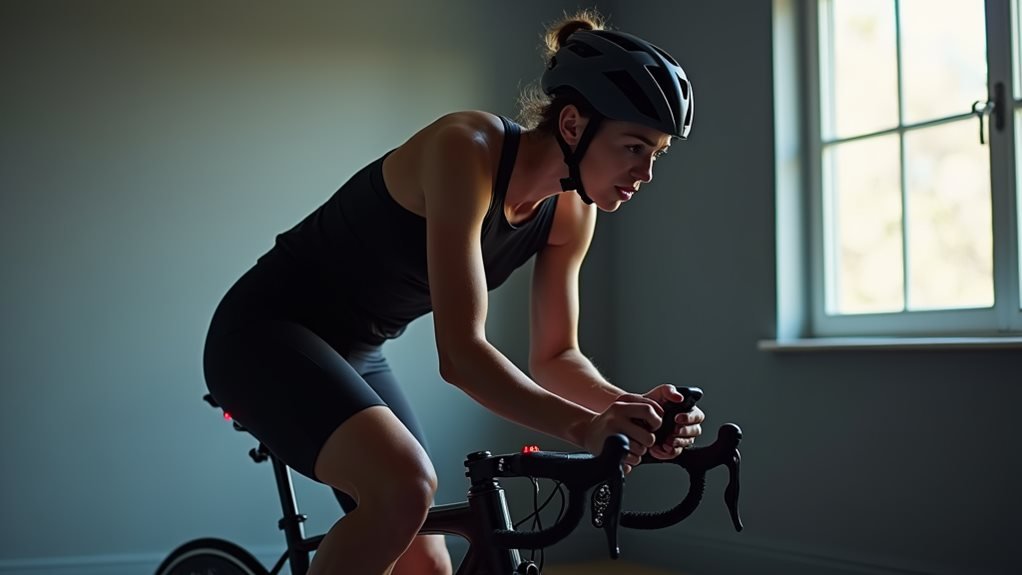
Your foundation in proper breathing technique sets the stage for building serious lung power. I'm going to show you how to transform those lungs into powerhouses through targeted respiratory training. Indoor cycling workouts can significantly improve lung capacity and overall respiratory function.
Let's start with diaphragmatic breathing – it's your secret weapon. Place your hands on your sternum and belly, then breathe so your stomach expands, not your chest. You'll feel the difference immediately. Using all respiratory muscles during breathing enables maximum efficiency. When you sit hunched over, you'll weaken your diaphragm, so maintain proper posture while practicing. I want you to practice this while maintaining perfect posture on your bike.
Next, we'll sync your breathing with your pedal strokes. Try this: inhale for three down-strokes, exhale for six. It's like a dance – once you get it, you'll wonder how you ever rode without it. Start on your trainer before taking it to the road.
For recovery, I'll let you in on a pro secret: extend those exhales. When you're gasping after an interval, take control with big, deliberate breaths. Focus on nose breathing during easy sessions – it's like strength training for your respiratory system. Trust me, your lungs will thank you when you're crushing those climbs.
Smart Training Strategies
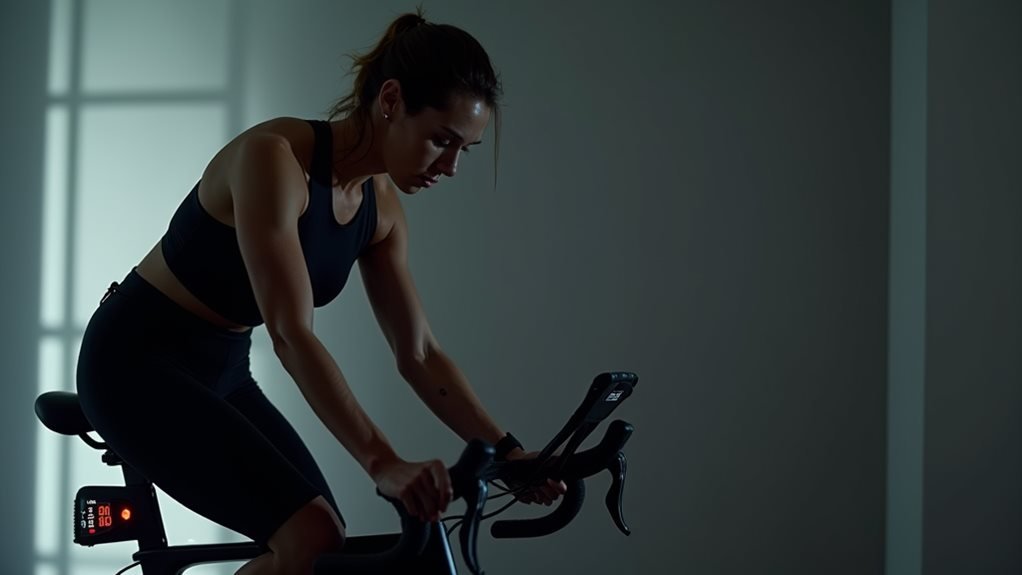
Every successful indoor cycling journey starts with a smart training strategy. I'll tell you right now – throwing yourself randomly at workouts won't cut it. You need a structured approach that leverages technology and smart training principles to maximize your lung capacity gains. With today's advanced indoor cycling platforms, you've got a powerful arsenal at your disposal. The controlled training environment allows you to focus entirely on your breathing technique without outdoor distractions. Using TrainerRoad plans helps optimize your training through adaptive algorithms that adjust to your progress.
Here's your battle plan for smarter breathing-focused training:
- Use ERG mode for precise power-controlled intervals – it's like having a drill sergeant forcing you to maintain peak output
- Implement progressive overload through structured training plans that gradually increase workout intensity
- Alternate between HIIT sessions for maximum oxygen uptake and sweet spot workouts for sustainable power
- Schedule active recovery rides between intense sessions to promote better oxygen utilization
I'm going to be straight with you – success comes from embracing both technology and science-based training principles. Your smart trainer's built-in sensors will track every breath and watt, while AI-driven workout suggestions keep you progressing. Don't waste time with guesswork when data-driven training can fast-track your respiratory fitness.
Safe Indoor Cycling Methods
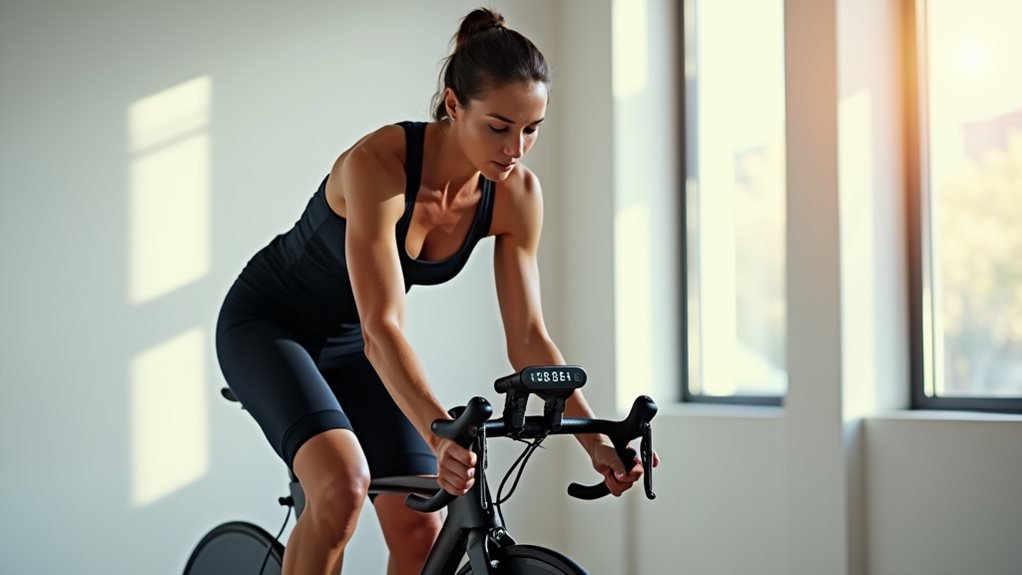
Setting up your static bike correctly can make or break your indoor cycling experience. I'll tell you straight – adjust that seat height until your leg's slightly bent at the bottom stroke, and position those handlebars level with your saddle. Keep feet flat while pedaling for balanced muscle engagement. Trust me, your back will thank you later.
Let's talk form because I've seen too many riders doing it wrong. Keep your back straight (yes, like your grandmother told you), and breathe from your belly. Don't death-grip those handlebars – a loose grip with slightly bent elbows is all you need. And please, stop bouncing in that saddle. It's not a mechanical bull. Push and pull through the full pedal stroke for maximum efficiency.
Here's what most people mess up: cadence and resistance. Don't go crazy with speed – anything above 110 rpm is asking for trouble. You need enough resistance to maintain control, but not so much that you're grinding your knees to dust.
I'm serious about this: warm up properly and cool down for 5-10 minutes. Skip this, and you'll regret it when muscle soreness hits tomorrow.
Frequently Asked Questions
How Long Does It Take to See Noticeable Improvements in Lung Capacity?
I'll tell you from experience: you can notice improvements in lung capacity within 4-6 weeks if you're working out 2-3 times weekly with steady intensity increases and consistent effort.
Can Allergies or Asthma Affect My Progress When Training on a Stationary Bike?
Yes, both allergies and asthma can impact your stationary bike progress. I recommend using prescribed medications before workouts, ensuring proper ventilation, and having your inhaler ready during training sessions.
Should I Breathe Differently During Warm-Up Compared to High-Intensity Intervals?
With nasal breathing offering 20% more oxygen absorption, I recommend slow, deep breaths during warm-up, then switch to mixed mouth-nose breathing with increased respiratory rate during high-intensity intervals.
Does Air Temperature in My Indoor Training Space Affect Breathing Performance?
I'd recommend keeping your indoor training space temperate, as hot and humid air can decrease your cycling performance. Breathing cooler air helps reduce discomfort and lets you maintain better power output.
Can Supplemental Breathing Exercises off the Bike Enhance Cycling Performance?
I've found daily breathing exercises can boost breathing efficiency by 10%. I recommend doing belly breathing and performance counts (2-2-4) off the bike to strengthen your respiratory system for cycling.
